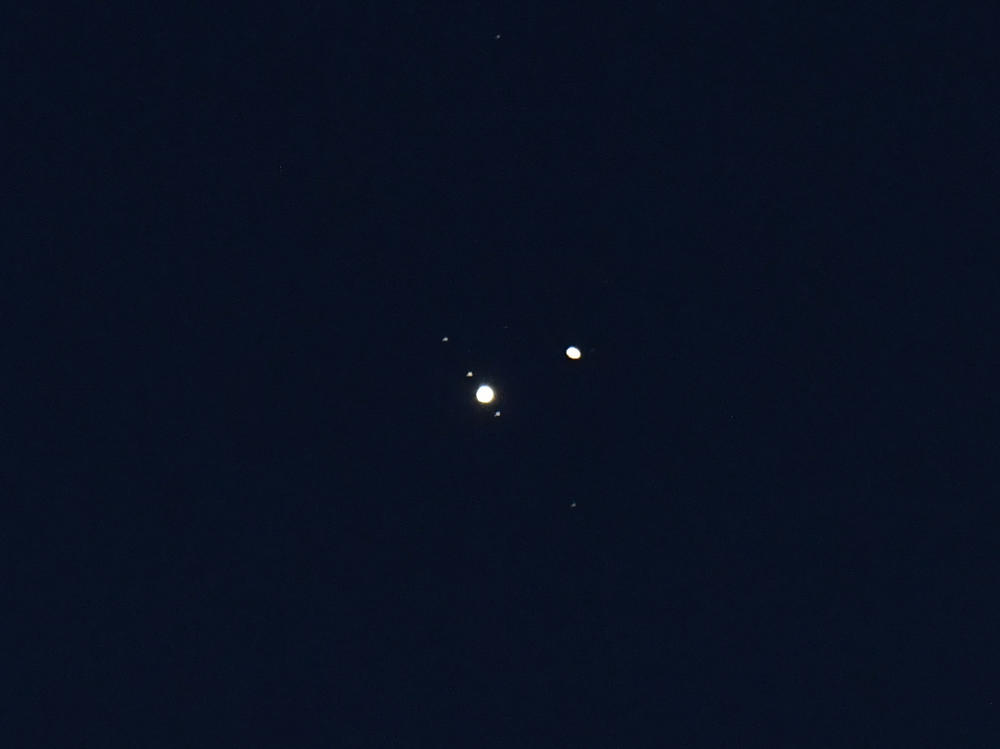Section Branding
Header Content
Saturn Will Soon Put On Its Best Show Of The Year. Here's Where And How To See It
Primary Content
Now might be the time to wipe the dust off that pair of binoculars and extract the family telescope from the back of the closet: Saturn is about to put on its best and brightest show, looking spiffier than at any time during the year – a performance that will be followed a few weeks later by Jupiter.
The ringed planet will be at opposition on Sunday for people in North America. What exactly does that mean? Imagine Earth and Saturn are hands on a clock face, says Phil Plait, an astronomer and longtime science educator. "So very roughly once a year, Saturn, Earth and the sun line up," he tells NPR.
It's the perfect time of year to go outside an hour or so after sunset and look low in the east-southeast for Saturn.
"The brightest 'star' you'll see not far above the horizon is Jupiter, and Saturn is the fainter yellowish object about two fists seen at arm's length to its upper right," Rick Fienberg of the American Astronomical Society writes in an email to NPR.
"You shouldn't mistake it for anything else. There are some bright spots up in the sky, but they're going to be in the west mostly," Plait adds.
With binoculars, you should get a sense for Saturn's rings
What will you see? With the unaided eye, Saturn will appear somewhat brighter than normal, but "most casual observers won't notice much of a change at all," Sarah Burcher, public program manager at the Lowell Observatory in Flagstaff, Ariz., tells NPR. However, with binoculars or a small telescope — and good seeing — you'll have the best chance all year to catch some really interesting detail.
Even with binoculars, you can get a sense of the rings. With a decent, small telescope — a 4-inch reflector, for example — the detail should pop out — including a big gap in the middle of the ring system, known as the Cassini Division (after Italian-born astronomer and mathematician Giovanni Domenico Cassini), says Wayne Schlingman, director of the Arne Slettebak Planetarium at Ohio State University.
If you're lucky, you might also catch a glimpse of Titan, Saturn's largest moon.
"Through a small telescope, Titan is actually pretty easy," Plait says. "If you take a look, you might see a little star right next to Saturn. That might very well be Titan — you can go online and find planetarium software" to confirm it.
Saturn will be at its best for viewing for a few weeks
Many astronomical events are a one-shot deal. Cloudy skies, poor seeing or failure to set a wake-up alarm, and they are missed altogether. Not so for Saturn's (or Jupiter's) opposition.
You've got a few weeks and all night to see Saturn at its best.
"So start looking now, and don't fret if it's cloudy on August 1st – just keep looking every evening thereafter," Fienberg writes.
More advanced amateur astronomers have been capturing especially stunning images of Saturn for weeks now as opposition approaches. Typically, these backyard stargazers "stack" the clearest images they can get to achieve the best results.
Sam Lojacono, a math and science teacher from upstate New York, has been interested in astronomy since his youth. But he has picked up astrophotography just since the pandemic. Using reflector telescopes with apertures of 8 inches and 12 inches, he's been having increasing success with photographing Saturn as it "grows bigger through the telescope," he tells NPR.
"Unfortunately for every two days, I have to deal with three days of rain, and the atmosphere is very unstable," Lojacono laments. "There are some days I'm able to get a clear shot, and other days the image just looks warbled."
After Saturn's opposition, get ready for Jupiter
He's already getting some nice shots of Jupiter, too. The largest planet in the solar system reaches opposition around Aug. 19.
Burcher says, "Jupiter's opposition will be, in my opinion, a more exciting event." The planet's surface "is far more visually dynamic than Saturn, and when it is closer to Earth, these features can become more apparent."
If you don't have your own telescope — or if the one you own is on the diminutive side of astronomical instrumentation — it might be worth seeking out a bigger scope, possibly through a local astronomy club.
"Larger telescopes can also help bring out color to help distinguish cloud bands on the surface of Saturn or the striking orange hue of Titan," Burcher says. "You may also see Saturn's other moons, such as Enceladus, Rhea or Dione. These will appear to be points of light, like stars, within a couple ring-widths of the planet."
Copyright 2021 NPR. To see more, visit https://www.npr.org.

